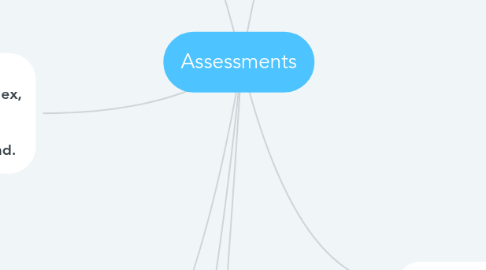Assessments
af Brad Barrett


1. summative: evaluate student learning at the end of an instructional unit by comparing it against some standard or benchmark.
1.1. Advantages: 1. Offers students a target (end goal) for their study efforts. 2. Used as a guide for assessing student capability/knowledge in a subject. 3. Convenient. 4. Can be implemented quickly. 5. Can be easily adapted for specific classrooms/students.
1.2. Disadvantages: 1. Measures relatively superficial knowledge or learning. 2. Vulnerable to student theft and distribution. 3. Results may not be easily generalized beyond the program or institution. 4. no feedback to students as the module is over by exam time
1.3. Purpose: To check level of student learning at the end of instruction on a given set of concepts/ideas/learning criteria.
1.4. "Of" or "for" learning: Summative assessments are designed to be an assessment of learning.
1.5. Example: End of unit exam and essay.
2. performance-based: Assessments that are complex, authentic, process/product-oriented, open-ended, and time-bound.
2.1. Advantages: 1. Can be used to assess from multiple perspectives 2. • Can be used to assess transfer of skills and integration of content 3. Can promote student creativity 4. Can place faculty more in a mentor role than as judge 5. Can provide an avenue for student self-assessment and reflection
2.2. Disadvantages: 1. Usually the most costly approach 2. Time consuming and labor intensive to design and execute for faculty and students 3. Must be carefully designed if used to document obtainment of student learning outcomes 4. Grade can be more subjective
2.3. Purpose: To give students an opportunity to demonstrate knowledge and skills in a process that often requires the transfer of other skills and content knowledge.
2.4. "Of" or "for" learning: PBA can serve both. They can be purposefully designed to assess learning or advance learning. Usually there is a component of each.
2.5. Example: 1. • Oral presentations 2. Products 3. • Supervised internships & practicums
3. high-stakes: Any test used to make important decisions about students, educators, schools, or districts, most commonly for the purpose of accountability
3.1. Advantages: 1. Are scored objectively. 2. Provide for external validity. 3. Provide reference group measures.
3.2. Disadvantages: 1. Measures relatively superficial knowledge or learning. 2. Unlikely to match the specific goals and objectives of a program/institution 3. More summative than formative (may be difficult to isolate what changes are needed).
3.3. Purpose: Keep students, educators, and institutions accountable to goals/ standards.
3.4. "Of" or "for" learning: These tests are used as a measure of learning.
3.5. Example: 1. ACT 2. MAP testing
3.5.1. Example:

